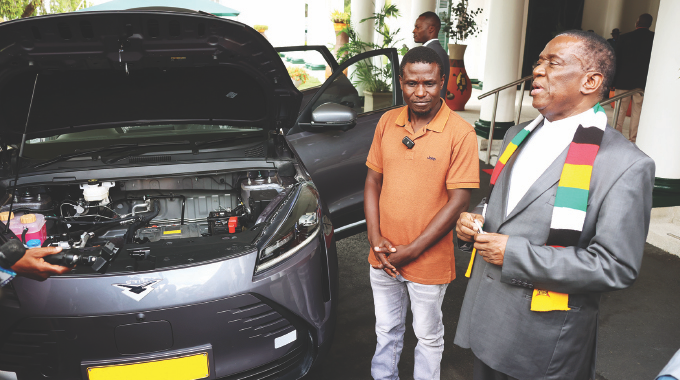In a stunning reversal, social media accounts belonging to Zimbabwe’s Ministry of Information, Publicity & Broadcasting Services, Permanent Secretary Nick Mangwana, and even President Emmerson Mnangagwa have quietly erased their celebratory posts about Maxwell Chikumbutso and his purportedly groundbreaking technology. The move raises serious questions about whether the government was duped into endorsing what many are now calling a modern-day hoax.
Just days ago, Zimbabweans watched as President Mnangagwa cut short his national leave to personally witness Chikumbutso’s “world-first” technology at State House. The inventor showcased a range of alleged innovations, including the Saith FEV, a car supposedly powered entirely by radio waves, requiring no fuel or recharging, a hypersonic energy device, and a radio frequency-powered motorbike.
Visibly impressed, Mnangagwa heaped praise on Chikumbutso, remarking, “This is the only vehicle of its kind in the world, there is no other. When he first came to talk to me, I thought he was not properly wired in his head, but I now know that he is well connected.” He went further to claim that the United States had offered Chikumbutso US$3 million to stay and develop his work there, but the inventor chose to remain in Zimbabwe.
The Ministry of Information amplified this excitement on X (formerly Twitter), posting, “Chikumbutso made one of the world’s first cars that need no fuel, no recharging, no input. The Saith FEV is a full self-powering electric vehicle, which is powered entirely by radio waves.” But as skepticism mounted, the government deleted all its posts on the matter, raising speculation that they now see Chikumbutso’s claims as dubious.
While many Zimbabweans initially took pride in what seemed like a revolutionary scientific breakthrough, experts quickly pointed out that a vehicle powered solely by radio waves defies established physics. Scientists argue that radio waves do not carry enough energy to independently power an electric vehicle. The lack of technical validation and independent testing has fueled growing doubts, with some questioning whether Chikumbutso was indeed the inventor of the showcased technology.
Social media erupted with debate. One user, @Tinashe_M, asked, “Where is the proof that Chikumbutso actually built these things? Why does he have no patents?” Another, @ZimScientist, commented, “A self-powering car? Really? This is another Diesel Rock moment. Government officials never learn.” However, some defended Chikumbutso, with @ProudlyZim arguing, “Western scientists always doubt African inventors. Chikumbutso deserves a chance!”
Beyond the immediate controversy, questions have emerged about Zimbabwe’s capacity to verify and authenticate technological inventions. The Standards Association of Zimbabwe (SAZ) oversees product certification in traditional industries, but there is no widely recognized body responsible for testing radical scientific claims. Experts argue that a dedicated innovation regulatory body could prevent government officials from endorsing unverified technologies in the future.
The situation has drawn comparisons to the infamous Diesel Rock hoax of 2007, when self-proclaimed spirit medium Rotina Mavhunga (Nomatter Tagarira) convinced government ministers that a rock in Chinhoyi was producing refined diesel. Top officials, including military generals, rushed to the site and even removed their shoes in reverence before eventually realizing they had been duped. Mavhunga was later convicted of fraud. The parallels are difficult to ignore.
With the government now silent and its social media posts erased, it remains unclear whether Chikumbutso’s claims will be formally investigated or quietly buried. What is clear, however, is that extraordinary claims require extraordinary proof, and Zimbabwe cannot afford another scientific embarrassment on the world stage.












Comments